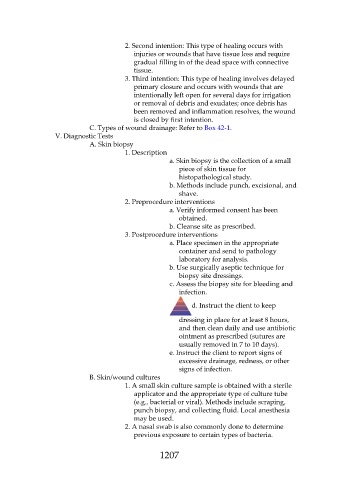Page 1207 - Saunders Comprehensive Review For NCLEX-RN
P. 1207
2. Second intention: This type of healing occurs with
injuries or wounds that have tissue loss and require
gradual filling in of the dead space with connective
tissue.
3. Third intention: This type of healing involves delayed
primary closure and occurs with wounds that are
intentionally left open for several days for irrigation
or removal of debris and exudates; once debris has
been removed and inflammation resolves, the wound
is closed by first intention.
C. Types of wound drainage: Refer to Box 42-1.
V. Diagnostic Tests
A. Skin biopsy
1. Description
a. Skin biopsy is the collection of a small
piece of skin tissue for
histopathological study.
b. Methods include punch, excisional, and
shave.
2. Preprocedure interventions
a. Verify informed consent has been
obtained.
b. Cleanse site as prescribed.
3. Postprocedure interventions
a. Place specimen in the appropriate
container and send to pathology
laboratory for analysis.
b. Use surgically aseptic technique for
biopsy site dressings.
c. Assess the biopsy site for bleeding and
infection.
d. Instruct the client to keep
dressing in place for at least 8 hours,
and then clean daily and use antibiotic
ointment as prescribed (sutures are
usually removed in 7 to 10 days).
e. Instruct the client to report signs of
excessive drainage, redness, or other
signs of infection.
B. Skin/wound cultures
1. A small skin culture sample is obtained with a sterile
applicator and the appropriate type of culture tube
(e.g., bacterial or viral). Methods include scraping,
punch biopsy, and collecting fluid. Local anesthesia
may be used.
2. A nasal swab is also commonly done to determine
previous exposure to certain types of bacteria.
1207

